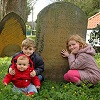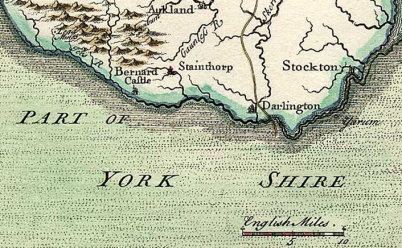This post is inspired by the BBC television programme ‘Hidden Histories: Britain’s Oldest Family Businesses‘, specifically the episode about Balson’s butchers of Bridport in Dorset. My own family history can’t compete with Richard Balson’s: his ancestors have been butchers in the same town since 1515, only a few years into the reign of Henry VIII – five hundred years ago and counting – but there was an unbroken line of Stainthorp butchers in the north-east of England for at least 127 years:
- Charles Stainthorp (1835-1905)
- William Stainthorp (1862-1924); also his sons Frank (1886-1918) and Charles (1887-1945)
- Henry Harland “Harry” Stainthorp (1904-1952)
- William “Bill” Stainthorp (1929-2010)
Another difference between my line of butchers and the Balsons: while they have been in Bridport throughout their long history, my ancestors moved regularly, running shops in Hutton Rudby (Yorkshire), Middlesbrough, Sunderland, Seaham (County Durham), Gateshead, Wallsend, Whitley Bay, and possibly elsewhere, and branched out into the dairy business and into running licensed premises.
Before we were butchers
I’ve already written about my ancestors Francis (1765-1822) and his son Francis (1803-1882) Stainthorp, who were both hand-loom weavers of linen in the Yorkshire village of Hutton Rudby. Weaving was the main occupation in Hutton, and my Stainthorp ancestors had been weavers since at least the 1690s.1,2
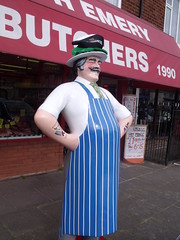
Butcher’s figure / dummy
© Copyright Elliott Brown and licensed for reuse under this Creative Commons Licence.
The Stainthorps of Hutton Rudby were also farmers, again since at least the late 17th century,1 owning between 15 and 22 acres of land at Enterpen and North End.4,5 They will have slaughtered their own livestock and sold the meat locally and at nearby Stokesley market.
The booklet ‘A History Walk round Hutton Rudby‘ notes the “great many” butchers and slaughterers that were based in Hutton Rudby from the middle of the 19th century onwards, and describes some of the less-pleasant effects on the village environment:
“…the butchers’ refuse was dumped in the Blood Midden – the ponds off Green Lane to the west of Campion Lane. The smell was dreadful, especially when the farmer spread the rotted waste as muck, but it was a very popular place to go ratting, as the rats there grew “as big as terriers”.
– ‘A History Walk round Hutton Rudby’.6
One of these 19th-century butchers was my three-greats grandfather Charles Stainthorp.
Charles Stainthorp (1835-1905), butcher, farmer and dairyman
Charles was born in November 1835, the youngest and only surviving son of my four-greats grandfather, linen weaver Francis Stainthorp (1803-1882) and his wife Ann Seamer (1800-1883).2 He had two older brothers, William and Francis, who both died young of consumption – i.e. tuberculosis.7 Charles grew up with his parents at North End, Hutton Rudby;8 he is in the 1851 census of England as a fifteen-year-old farmer’s servant, in the household of farmer Ralph Agar at Tees Tilery, Normanby-on-Tees.9
In 1859, just before he married grocer’s daughter Ann Kay at Rudby All Saints’ church,2 Charles set himself up in business as a butcher with £50 capital.10 His first shop was located in Enterpen, which is the name of both a road and an associated hamlet-cum-suburb of Hutton Rudby proper.11
At first, Charles was the picture of the successful rural small businessman. He and Ann had six children (tragically, three died in childhood including their two-year-old daughter Phillis who was fatally injured when she fell out of her father’s butcher’s cart while travelling home from his shop in Enterpen).11 Charles also had an apprentice, the splendidly-named Denton Fortune, who later became a butcher in his own right in East Rounton.4,5 He continued to farm sheep on the family land in Hutton,12 and also bred and exhibited prize-winning greyhounds.13 During the 1860s, Charles Stainthorp held the role of chairman/vice-chairman of the local Friendly Society and presided over their annual dinners.14
By 1883, Charles and his son William had a butcher’s shop at 87 Linthorpe Road, Middlesbrough.15 This building still exists, and in 2016 was occupied by a branch of the electronic goods retailer, Maplin.

Christmas advertisement
The North-Eastern Daily Gazette [Middlesbrough],
22 December 1883, p. 2
By the end of 1887 Charles knew he was falling into insolvency. On 10 April 1889, at court in Stockton-on-Tees, he was declared bankrupt with debts of £686 3s 3d – close to £57,000 in today’s money.18
The Stainthorp family farm was sold, and Charles and William Stainthorp both left Hutton Rudby for good. There were no Stainthorps left in Hutton by the end of the nineteenth century.
Charles moved: first to nearby Skelton-in-Cleveland where son William was also living, and later to the Heaton area of Newcastle upon Tyne. By this time Charles had remarried, to Sarah Wood.19 27 years his junior – younger in fact than Charles’ eldest daughter – Sarah had been living in Enterpen, Hutton Rudby, and had two sons baptised and registered under her own surname.2 It’s not clear whether John George Wood and Joseph Wood were actually Charles Stainthorp’s biological sons, but he raised them as his own children and they both took the surname Stainthorp after Charles and Sarah were married.20–22
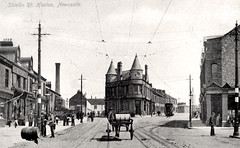
Shields Road, Heaton, 1908
Public domain image, Newcastle Libraries
Sarah died in Heaton in 1904; Charles Stainthorp, “milk salesman formerly a butcher (master)“, passed away a year later on 21 November 1905, at the age of 70.7
William Stainthorp (1862-1924), butcher and publican;
also his sons Frank (1886-1918) and Charles (1887-1945)
My great-great grandfather William was the second child and eldest son of Charles Stainthorp and his first wife Ann (née Kay). He was born on 27 January 1862 in Hutton Rudby;25 by the time of the 1881 census he was working in his father’s butcher’s shop in Enterpen.5 Perhaps in order to strike out on his own in business, William later took out an £80 bank loan on which his father Charles was guarantor.10
When he married Margaret Annie Harland in 1884, William was living at the family butcher’s shop in Middlesbrough, at 87 Linthorpe Road.19
Margaret Harland was from a County Durham family of iron workers, but in recent years her father William Harland had been landlord of a string of Teesside pubs including the Cleveland Arms, North Ormesby, the Clarendon Hotel, Marske, the Tees Inn and the Lord Byron, Middlesbrough … and last of all the Royal Hotel, Redcar, where William Harland died in 1892, after falling down the stairs of his own pub.26 Margaret’s brother Henry Harland and half-brother William Dobson were also publicans.4,5,20
At first William and Margaret Stainthorp followed their Harland relatives into the licensed trade. In the late 1880s William was the keeper of the Crown & Anchor Hotel, High Street, Redcar (their first two children were born there)25; at the same time it appears they also ran a separate lodging house down the road at 135 High Street, Redcar – however they definitely still had the Middlesbrough butcher’s shop as late as 1887, and William’s occupation is recorded sometimes as an innkeeper, sometimes a butcher.25
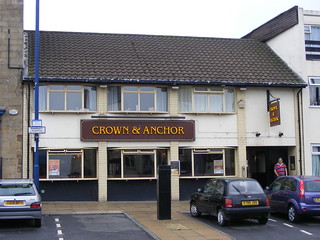
Crown & Anchor Hotel, Redcar
The building would have looked significantly different in William Stainthorp’s day, with an additional top floor demolished after 1961.
© Copyright emdjt42, all rights reserved
In the 1891 census William appears as a licensed victualler, landlord of the New Inn, 1-3 Cleveland Street, Skelton-in-Cleveland: two more of their children were born in those premises.20,25
In 1895, William, Margaret and their five children embarked on their next major move. (A sixth child, named William Harland Stainthorp after his maternal grandfather, had died aged 13 months of measles and is buried in Skelton cemetery.)27 By the end of that year the family were in Hartlepool;28 almost immediately they moved again, northwards to the area of Tunstall/New Silksworth, near Sunderland. (With all the chaos of these multiple moves, they neglected to register the birth of their youngest child.) Nowadays New Silksworth is part of the built-up metropolitan area of Sunderland. When my ancestors moved there it was a small colliery village of newly-built miners’ houses, surrounded by open fields.
This move also marks the end of William and Margaret’s career in the licensed trade, although two of their daughters married publicans, and Margaret Annie Stainthorp – like her father – died in a pub.7
Between 1897-1904, the Stainthorps lived at 57 Castlereagh Street, New Silksworth, Tunstall. Margaret and William’s last three children were born there, including the youngest of all, my great grandfather, Henry Harland Stainthorp (1904-1952).25 57 Castlereagh Street is at the corner of two streets and is currently a shop – in 2016, Devito’s pizza takeaway; before that a BMX bike shop – so it may well have been the location of William’s butcher’s shop in the early 1900s.
The impression given by snippets from the Sunderland Daily Echo is that William’s business was thriving in the first few years of the 20th century. In 1901 he advertised both for a “STRONG, respectable GIRL” to work as a general servant and for a “good MAN, capable of taking charge” of the shop in Silksworth.29 (A few years later he placed an advert in the same newspaper for a lost black-faced sheep… had his new assistant left the slaughterhouse gate open, letting William’s profits run away on four legs?)30

Birth announcement
Sunderland Daily Echo, 24 July 1901, p. 2
There is also an entry in Kelly’s Directory of Durham, 1902, for William Stainthorp, butcher, at 3 Trimdon Street West in the Millfield area of Sunderland. This can only be my two-greats grandfather, but I have no other record of a butcher’s shop at this address (which is right across the other side of the city from their home in New Silksworth), and the original buildings on Trimdon Street West have now disappeared.31
After 1904, the Stainthorp family moved two more times: to Horden in County Durham by 1911,22 then, around the end of the First World War, to the Northumberland seaside resort of Whitley Bay. I do not know where William’s shop or shops were located during this period. (As late as 1921, the butcher’s shop at 215 High Street East, Wallsend, which would later belong to William’s youngest son Henry, was being operated by a Mr William Coupe; before that by J. Cosans.)32,33
William died of a stroke at his home in Whitley Bay on 4 March 1924. His widow Margaret died fourteen years later at the Gladstone Hotel, Scotswood Road, Newcastle upon Tyne:7 I don’t know whether she was there merely as a customer or as the mother/mother-in-law of the licensee.
(Other pubs run by the descendents of William and Margaret include the Biddick Inn, Fatfield, and the Gibraltar Rock, Tynemouth. It’s likely there were many more but that will have to be the subject of a future blog post and a punishing genealogical pub crawl.)
My grandfather, born five years after William Stainthorp senior passed away, remembered his grandmother Margaret as a “sweet, quiet old lady”. He had less-fond memories of his aunt Madge – William & Margaret’s eldest child – who sent him to bed in the afternoon for misbehaving.34
Three of Margaret and William’s sons carried on the family butchery business: my great grandfather Henry Harland Stainthorp (below), and his two older brothers Frank and Charles:
Francis “Frank” Stainthorp (1886-1918)
I have already written about Frank Stainthorp, who was killed on 31 October 1918 near Kerkhove in western Flanders while serving with the 19th Battalion, Durham Light Infantry.35The second child and eldest son of Margaret and William, before the war I believe Frank ran his own butcher’s shop in Seaham, although I have not been able to find the exact location.
He married Mary Helena Mason (known as “Lena”) in Sunderland on 28 July 1919 – they had two daughters.19
Frank carried his peacetime trade into the Army: when he was up in court in 1915 for being so drunk at Chesterfield Midland railway station that he jumped onto the railway line and had to be dragged out of the path of an oncoming train(!), he told the magistrate that he was butcher to his battalion.36 (He was demoted from lance corporal back to the rank of private for this instance of being drunk and A.W.O.L.)37
Frank Stainthorp may have been butchering right up to his untimely death. The family story is that he was doing his rounds, “bringing food up to the front” when the call went out for volunteers for a mission into no-man’s land to rescue a wounded soldier. Frank volunteered for the mission and never returned.34
As an aside, what happened to Frank Stainthorp’s widow and two children after WWI is still one of the major mysteries in my family history research.
Charles Stainthorp (1887-1945)
Frank Stainthorp’s younger brother Charles was born above his namesake grandfather’s butcher’s shop at 87 Linthorpe Road, Middlesbrough on 23 November 1887.25 In 1911, he was working as a butcher alongside his father William, and living with his parents in Horden.22 On 11 December 1912 Charles married Margaret Elliott Smith at Gateshead register office.19

Charles Stainthorp
Family photograph, © all rights reserved
By 1939 Charles was living and operating out of a shop at 145 Sodhouse Bank, Sheriff Hill, Gateshead, supported by his three children: Sidney, Frank and Verita.
After Charles’ death in 1945, his middle son Frank Stainthorp (1916-1975) took over the shop in Sheriff Hill.
Stainthorp’s sausages are the best,
they’re good for your belly and your chest.
If you eat them twice a week
they’ll cure your sweaty feet!– Gateshead children’s rhyme34
This shop at 145 Sodhouse Bank is the earliest Stainthorp butcher’s that I have a photo of. I am extremely grateful to two of my relatives who both sent me copies of this photograph. It was probably taken after 1945. The man in the door in the white butcher’s apron is Charles Stainthorp’s son Frank.
The last record I have of Frank Stainthorp’s Gateshead shop is from 1952.39 It’s now a private house, though some of the original features have been preserved including butchers’ hooks in the ceiling.34

F. Stainthorp, butcher, Sodhouse Bank,
Sheriff Hill, Gateshead, after 1945?
Family photograph, © all rights reserved
Henry Harland “Harry” Stainthorp (1904-1952), master butcher

Henry Harland Stainthorp
Family photograph, © all rights reserved
Born in New Silksworth on 17 March 1904,25 Harry Stainthorp married my “Nana” – my great grandmother – Marion Curry at St Paul’s church, Whitley Bay, in 1928.19 The couple moved from Walkergate near Newcastle to the coastal village of Cullercoats – to Links Road, then in the 1940s to a house on the Broadway.7,25,40
From at least 1936 until his sudden death in 1952 (at just 48 years old),7 Harry Stainthorp had a shop at 215 High Street East, Wallsend, directly opposite Wallsend Town Hall.39,40 I am sure that a photograph of this shop must exist somewhere – perhaps in North Shields library’s collection of 50,000 local images.
The Wallsend shop is just off the right-hand edge of this commercially-available photograph.
When I passed the location of the shop on the High Street in 2015, the building was empty and shuttered.
Harry seems to have had an odd sense of humour: during the Second World War he had more than one letter published in the Newcastle Evening Chronicle in which he commented on the more absurd aspects of wartime restrictions, including a poem about the honey-trap agents apparently used by the Ministry of Food to ensnare an unwary Wallsend butcher tempted to bend the rules on rationing…

Medallion and sash of the
Tynemouth Butchers’ Association
which belonged to my grandfather.
© Copyright stainthorp_ph,
all rights reserved
“BUTCHER’S LAMENT”
You may talk about your ration,
Through teeth you can’t help gnashin’,
While knittin’ scarves to warm the soldiers’ throats.
But when it comes to duty,
I can tell you of a beauty,
Whose job’s to make the butchers burn their boats.There’s a girl I’ve heard them say
In the Food Controller’s pay
Who plys her trade with nothin’ but good looks;
She flits from shop to shop
Like a sparrow on the hop
To buy some meat without her ration books.With her “Please, please, please,”
She’s almost on her knees;
The butcher tries to meet those eyes that melt;
The mutt succumbs at last,
And wraps her meat up fast,
And another scalp is added to her belt.– H. Stainthorp, Cullercoats, 1940.41
William “Bill” Stainthorp (1929-2010), master butcher
When his father Harry Stainthorp died unexpectedly in 1952, my grandad Bill Stainthorp gave up his job as a bank clerk with Lloyd’s Bank and his expected future career, to take over the family business.34,42 He was joined in this at first by his brother Robin (1937-2007), who later went into the insurance industry. A third brother, Norman (1944-2006) emigrated to New South Wales in the 1970s.
William “Bill” Stainthorp was born on 7 July 1929 in Wingrove Road, Fenham, Newcastle upon Tyne.25
He ran his late father’s shop at 215 High Street East, Wallsend until about 1967.39

W. Stainthorp, butcher, Ilfracombe Gardens, Whitley Bay, about 1985.
Family photograph, © all rights reserved
In 1974, William Stainthorp was taken to court by the trading standards department of the newly-formed Tyne & Wear County Council for selling brawn (which contains 60% meat, the rest being jelly) in his Whitley Bay shop under the name “potted meat” (which by law must be a minimum of 95% meat). His argument that “it is one of the quirks in the North-East for people to call brawn potted meat” – and that only “visitors from the south” called it by its ‘proper’ name – fell on unsympathetic ears and he was fined £10 and ordered to pay £10 costs.43
I can remember visiting my grandad’s shop as a child – I have a clear mental picture of the layout of the shop, the cold room up a couple of steps, and a small yard out the back. For some reason certain details have particularly stuck in my mind – the smell of the shop, sawdust on the floor, my grandad’s collection of pottery pig ornaments in the window, and containers full of tripe and pease pudding (“Geordie hummus”!) in the display cabinet.
Bill Stainthorp retired in 1986,34 127 years after his great grandfather Charles Stainthorp started out in business in Hutton Rudby. As far as I know my grandad was the last of the line of Stainthorp butchers: by 2015 the shop on Ilfracombe Gardens was being used as the offices of a firm of heating engineers. Bill died after a fall, on holiday in Yorkshire in 2010.7

Timeline of identified Stainthorp butchers’ shops
Created using RootsMagic software. I have not been able to find the addresses of any shops between 1904 and about 1934.

Paul Harland Stainthorp (paul@paulstainthorp.com). Version 1.5, updated 18 September 2016.
References
- Exchequer Court of York, will and probate, Francis Stainthorpe (d. before 1 May 1693), Potto, Cleveland; Borthwick Institute for Archives, York.
- All Saints’ Church (Rudby, Yorkshire, England), parish registers; digital images, Findmypast (http://www.findmypast.co.uk/ : accessed 2 August 2016).
- Barrigan, Alice. ‘Epilogue.’ In: Remarkable, but still true: the story of the Revd R.J. Barlow and Hutton Rudby in the time of cholera. Guisborough: Westgate, 2007; HTML version, North Yorkshire History. http://northyorkshirehistory.blogspot.co.uk/ (accessed 15 October 2014).
- “1871 England Census,” digital images, Ancestry Library Edition (http://www.ancestrylibrary.com/ : accessed 18 December 2015); The National Archives, Kew.
- “1881 England Census,” digital images, Ancestry Library Edition (http://www.ancestrylibrary.com/ : accessed 18 December 2015); The National Archives, Kew.
- Barrigan, Alice. A History Walk round Hutton Rudby. Hutton Rudby History Society, 1997; HTML version, North Yorkshire History. http://northyorkshirehistory.blogspot.co.uk/ (accessed 9 September 2016).
- England and Wales, death certificate (certified copy); General Register Office, Southport.
- “1841 England Census,” digital images, Ancestry Library Edition (http://www.ancestrylibrary.com/ : accessed 18 December 2015); The National Archives, Kew.
- “1851 England Census,” digital images, Ancestry Library Edition (http://www.ancestrylibrary.com/ : accessed 18 December 2015); The National Archives, Kew.
- The York Herald, 4 April 1889, p. 3.
- The York Herald, 29 July 1871, p. 9.
- The Northern Echo [Darlington], 6 June 1881, p. 4.
- The Daily Gazette [Middlesbrough], 17 June 1879, p. 4.
- The York Herald, 4 January 1868, p. 5.
- The North-Eastern Daily Gazette [Middlesbrough], 22 December 1883, p. 2.
- The North-Eastern Daily Gazette [Middlesbrough], 6 July 1888.
- The North-Eastern Daily Gazette [Middlesbrough], 3 April 1889.
- The York Herald, 11 April 1889, p. 3.
- England and Wales, marriage certificate (certified copy); General Register Office, Southport.
- “1891 England Census,” digital images, Ancestry Library Edition (http://www.ancestrylibrary.com/ : accessed 18 December 2015); The National Archives, Kew.
- “1901 England Census,” digital images, Ancestry Library Edition (http://www.ancestrylibrary.com/ : accessed 18 December 2015); The National Archives, Kew.
- “1911 England Census,” digital images, Ancestry Library Edition (http://www.ancestrylibrary.com/ : accessed 18 December 2015); The National Archives, Kew.
- “1939 Register,” digital images, Findmypast (http://www.findmypast.co.uk/1939register : accessed 3 March 2016); The National Archives, Kew.
- Newcastle Journal and North Mail, 23 September 1940, p. 2.
- England and Wales, birth certificate (certified copy); General Register Office, Southport.
- The Yorkshire Herald [York], 25 August 1892, p. 3.
- Register of burials in the burial ground of Skelton; digital images, Deceasedonline (https://www.deceasedonline.com/: accessed 8 June 2016), 1893, p. 143; Redcar and Cleveland Borough Council.
- “National School Admission Registers & Log-Books 1870-1914,” digital images, Findmypast (http://www.findmypast.co.uk/ : accessed 5 October 2015).
- Sunderland Daily Echo, 4 March 1901, p. 5.
- Sunderland Daily Echo, 27 October 1904, p. 2.
- “UK, City and County Directories, 1766 – 1946,” digital images, Ancestry Library Edition (http://www.ancestrylibrary.com/ : accessed 6 June 2015), Kelly’s Directory of Durham, 1902.
- “Historical Directories of England & Wales,” digital images, University of Leicester Special Collections Online (http://specialcollections.le.ac.uk/ : accessed 13 September 2016), Ward’s Directory of Newcastle-on-Tyne, 1916.
- “UK, City and County Directories, 1766 – 1946,” digital images, Ancestry Library Edition (http://www.ancestrylibrary.com/ : accessed 6 June 2015), Kelly’s Directory of Northumberland, 1921.
- Personal e-mail; privately held by the author.
- Commonwealth War Graves Commission, “Find War Dead,” digital images, CWGC (http://www.cwgc.org/find-war-dead/ : accessed 1 April 2015).
- The Courier [Chesterfield], 5 June 1915, p. 6.
- “British Army WWI Service Records, 1914-1920,” digital images, Ancestry Library Edition (http://www.ancestrylibrary.com/ : accessed 11 March 2015); The National Archives, Kew.
- ‘Felling High Street,’ History of The Felling..in bite size bits, 9 May 2014. http://the-felling.blogspot.co.uk/ (accessed 14 September 2016).
- “British Phone Books, 1880-1984,” digital images, Ancestry Library Edition (http://www.ancestrylibrary.com/ : accessed 12 May 2015); BT Archives.
- “UK, City and County Directories, 1766 – 1946,” digital images, Ancestry Library Edition (http://www.ancestrylibrary.com/ : accessed 6 June 2015), Ward’s Directory of Whitley Bay, Tynemouth, North and South Shields, Jarrow, Wallsend, Newcastle… [etc.], 1936.
- Evening Chronicle [Newcastle upon Tyne], 9 May 1940, p. 4.
- “Find a will: Wills and Probate 1858 – 1996,” digital images, Gov.UK (https://probatesearch.service.gov.uk/#calendar : accessed 1 July 2015); National Probate Calendar.
- “Potted meat alleged to be ‘brawn’,” British Food Journal, vol. 77, issue 2 (March/April 1975), online archives, Emerald Insight (https://www.emeraldinsight.com/ : accessed 23 October 2014), p. 62.

